Pilates at Home: Low-Impact, High-Reward Workouts You Can Do Anywhere
Last Updated Jul 14, 2025

Your living room doesn’t need mirrors, machines, or mats to become your personal powerhouse.
Pilates taps into the strength of slow, intentional movement. It trains your core, steadies your breath, and tunes your focus—all without a single piece of equipment.
This means no rushing to a studio, no pressure to perform, and no rigid routine. Just a low-impact workout that meets you where you are, whether that’s five minutes between meetings or a quiet moment before bed.
Feel stronger, more centered, and deeply connected to your body. Build resilience with pilates in your own home, on your own terms.
Why Pilates is a Great Home Workout
Getting to the studio for a Pilates reformer class isn’t always realistic when you have tons of deadlines and family responsibilities to deal with on a daily basis. That's part of why pilates at home has surged in popularity for a reason—it’s incredibly easy to start. No bulky machines, no fancy studio required. Just a mat, a small space, and a little time. That’s why nearly 13 million people in the U.S. practice Pilates every year, many of them right in their living rooms.
Busy day? Squeeze in 15 minutes before your morning meeting. Craving something longer? Unroll your mat on a quiet weekend. Pilates adapts to your schedule, your energy level, and your space. You can move at your own pace, pause when you need to, and repeat what feels good. Whether you're easing in with the basics or exploring advanced variations, every move builds strength and control.
And yes—it works. One study in Healthcare journal found that virtual Pilates classes delivered the same benefits as in-person sessions. That means your living room can offer all the results of a high-end reformer class, no commute required.
So whether you’re flowing through a video on your bedroom floor or joining a Zoom class between calls, Pilates brings powerful benefits into your day—on your terms.
Here’s what you can expect when you make the mat room your studio.
- Increased core strength: Pilates exercise engage your deep abdominal muscles and back extensors to support your movement. This means you’ll have an easier time in your daily activities thanks to the stability from your core. A study found that every single participant enjoyed better balance and gross motor coordination after practicing Pilates regularly, as reported by Acta Neurologica Belgica.
- Improved flexibility: The controlled stretching and flowing movements slowly expand your range of motion without forcing your muscles beyond their limits. A study found that just participating in one Pilates workout increased flexibility in all participants, according to the Journal of Bodywork. Just one class, and you’ll start feeling looser and more mobile right away.
- Better posture: The constant focus on spinal alignment in Pilates gradually retrains your body to hold itself upright throughout the day. Studies found that Pilates has a positive impact on neck and back posture, according to a study from BMC Sports Science, Medicine and Rehabilitation.
- More mental wellbeing: The mind-body connection required in Pilates creates a natural stress relief similar to meditation that carries over into the rest of your day. Research involving more than 800 participants showed that practicing Pilates regularly led to significant decreases in depressive symptoms and anxiety, according to the Medicine journal.
Key Pilates Exercises for Home Practice
A handful of go-to Pilates moves is all it takes to build a strong, effective routine. These classic exercises work key muscle groups while reinforcing the control and precision that set Pilates apart. Start with the basics and layer in new variations as your strength and confidence grow.
Standing Side-Kick Series
This exercise challenges your balance while strengthening your outer thighs and glutes. Stand tall with one hand on a wall or chair for support, then lift one leg slightly to the side. Keeping your hips level and standing strong, kick the lifted leg forward and back in a controlled motion, as if you’re drawing a line on the floor with your toe.
The standing version is great for home practice because it requires no equipment and builds functional strength for daily activities like walking up stairs or stepping over things. Focus on keeping your torso still while your leg moves to teach your core to provide stability while your limbs work independently. Start with 8-10 kicks per leg and gradually increase as you get stronger.
Criss-Cross Exercise
This core exercise targets your obliques while improving coordination between your upper and lower body. Start by lying flat with your hands gently supporting your head and both knees drawn up toward your chest. Lift your shoulder blades off the mat and rotate your torso, bringing your right elbow toward your left knee while extending your right leg straight. Switch sides in a controlled rhythm, like you’re pedaling a bicycle in slow motion.
The key to this exercise is to rotate from your ribcage, not just moving your elbows around. Think about wrapping your ribs around your spine as you twist, and keep the movement slow enough that you can control every part of it. This exercise builds the kind of rotational strength that helps with activities like turning to look behind you while driving. Start with 6-8 rotations per side.
Glute Bridges
This foundational exercise strengthens your glutes and hamstrings while opening up tight hip flexors from sitting too much. Start by lying down with your feet planted firmly on the ground about hip-width apart and knees pointing toward the ceiling. Engage your glutes and push down through your heels to raise your pelvis, forming a bridge shape with your body from knees to chest. Hold for a moment at the top, then lower down slowly with control.
Glute bridges are perfect for beginners because they’re gentle on your back while still being incredibly effective for building lower body strength, making them a great entry point into strength training. Focus on squeezing your glutes at the top rather than just pushing your hips up as high as possible. This exercise helps counteract the effects of prolonged sitting and creates a strong base for more advanced movements. Start with 10-12 bridges and focus on the quality of each rep rather than speed.
The Plank
This full-body exercise strengthens your core while working your shoulders, glutes, and posture muscles. Begin in a push-up position with your hands directly under your shoulders. Engage your core and squeeze your glutes to form a straight line from head to heels. Keep your neck long and eyes slightly forward to stay aligned.
Planks are simple but powerful. They train your body to hold steady under pressure, which helps with everything from lifting groceries to standing tall at your desk. Try holding for 30–60 seconds. Drop to your knees if needed, or make it harder by tapping each shoulder or lifting one foot at a time to test your stability.
Roll-Up
This slow, controlled movement strengthens your abs while improving spinal mobility. Start flat on your back with legs extended and arms reaching overhead. Inhale to lift your arms, then exhale as you roll up one vertebra at a time, reaching toward your toes. Reverse the motion on your next exhale to return to the floor.
Roll-ups train your body to move fluidly and with control—think of it as a sit-up’s smarter cousin. If needed, bend your knees or use a towel behind your legs. Want more challenge? Add pulses at the top. This movement builds core strength and flexibility in a single smooth motion.
Stretch Forward
This seated stretch improves flexibility in your hamstrings, spine, and upper back. Sit tall with your legs extended and feet flexed. Inhale to lengthen your spine, then exhale and reach forward with rounded arms and a gentle curve in your back, reaching toward your toes.
This stretch helps release tension from the lower back and legs, especially after long periods of sitting. Keep a soft bend in your knees if your hamstrings feel tight. For more depth, add slow pulses at the end of your reach. Hold for 30–60 seconds and focus on breathing into the stretch.
Swan Dive
This back-strengthening exercise targets the spine, glutes, and posture muscles. Lie face down with legs together and hands under your shoulders. Engage your glutes and press your feet into the floor. Inhale to lift your chest using your back muscles—not your hands—then lower slowly.
Swan dives help counteract the slouched-forward posture from screens and desks. Keep the motion small at first. Need a boost? Add a tiny pulse at the top. This movement wakes up your back body and leaves you feeling longer and stronger. Start with six to eight reps.
Safety Tips for Home Workouts
Practicing Pilates at home is generally very safe. But taking a few precautions can help you avoid injury and get better results from your workouts. All you need is to practice Pilates twice a week for 30 minutes to get positive results, according to a study from the Archives of Rehabilitation Research and Clinical Translation.
The most important thing is to be consistent and use proper technique rather than pushing yourself too hard too fast. Try sticking to these general guidelines to keep your home practice safe and effective:
- Maintain proper form: Start with the basic exercises and focus on executing them correctly rather than trying advanced movements right away. Watch instructional videos carefully and pause to check your alignment. It’s always better to do five perfect repetitions than 20 sloppy ones.
- Listen to your body’s signals: Stop if you feel sharp pain, dizziness, or unusual discomfort beyond normal muscle fatigue. Your energy and flexibility will vary from day to day. Modify exercises as needed rather than forcing your body into positions that don’t feel right.
- Create enough space: Clear enough room around your mat so you can extend your arms and legs fully without hitting furniture or walls. Poor lighting or cramped spaces can force you to adjust your movements in ways that can strain muscles or joints differently than intended.
- Use the right props: If an exercise calls for props you don’t have, find safe substitutions or skip it rather than using inappropriate items that might slip or break. For example, a folded towel works better than a slippery pillow for support.
- Warm up every time: Spend a few minutes moving gently before jumping into your main exercises, especially if you’ve been sitting for a long period of time or exercising first thing in the morning.
Creating a Pilates Routine
Building a sustainable pilates routine at home is much easier when you have access to quality instruction and variety in your workouts. Consistency matters more than perfection, so find an approach that fits your schedule and keeps you motivated to show up regularly.
Club Pilates, available through Wellhub, gives you access to both virtual and in-person classes with professional instructors who guide you through proper form and progressions. Apple Fitness+ also has high-quality, instructor-led Pilates videos that you can follow from home anytime, including options that combine Pilates with light cardio for a more dynamic workout.
Check if Wellhub is included in your benefits package and start building a Pilates routine that works for your lifestyle today. If you don’t have access, you can start a petition to bring Wellhub to your workplace and share the benefits of Pilates with your coworkers.

Want Wellhub at your company? Start a petition.
It’s completely confidential! Just follow a few steps and we'll create your official company petition page.
References:
- Al-Nemr, A., & Reffat, S. (2024). Effect of Pilates exercises on balance and gross motor coordination in children with Down syndrome. Acta Neurologica Belgica. https://doi.org/10.1007/s13760-024-02517-w
- Carine Lazarowitz Zanzuri, Hadas, D., Hutzler, Y., Goral, A., & Tsuk, S. (2024). Remote Pilates training is effective in improving physical fitness in healthy women: a randomized controlled study. Healthcare (Basel), 12(7), 724–724. https://doi.org/10.3390/healthcare12070724
- Ju, M., Zhang, Z., Tao, X., Ye, L., Gao, L., & Yu, W. (2023). The impact of Pilates exercise for depression symptoms in female patients: A systematic review and meta-analysis. Medicine, 102(41), e35419–e35419. https://doi.org/10.1097/md.0000000000035419
- Li, F., Dev, R., Kim Geok Soh, Wang, C., & Yuan, Y. (2024a). Effects of Pilates exercises on spine deformities and posture: a systematic review. BMC Sports Science, Medicine and Rehabilitation, 16(1). https://doi.org/10.1186/s13102-024-00843-3
- Li, F., Dev, R., Kim Geok Soh, Wang, C., & Yuan, Y. (2024b). Effects of Pilates on body posture: a systematic review. Archives of Rehabilitation Research and Clinical Translation, 6(3), 100345–100345. https://doi.org/10.1016/j.arrct.2024.100345
- Pires, K. A., Rocha, D. S., Rosano, R., Silva, O. O., Flor, R., & Dernival Bertoncello. (2024). Acute effects of a pilates method session on flexibility and performance in practitioners of an extreme conditioning program: A preliminary study. Journal of Bodywork and Movement Therapies, 39, 330–334. https://doi.org/10.1016/j.jbmt.2024.03.017
- Statista. (2025). Pilates training: number of participants U.S. 2018. https://www.statista.com/statistics/191616/participants-in-pilates-training-in-the-us-since-2006/
Category
Share

The Wellhub Editorial Team empowers HR leaders to support worker wellbeing. Our original research, trend analyses, and helpful how-tos provide the tools they need to improve workforce wellness in today's fast-shifting professional landscape.
Subscribe
Our weekly newsletter is your source of education and inspiration to help you create a corporate wellness program that actually matters.
Subscribe
Our weekly newsletter is your source of education and inspiration to help you create a corporate wellness program that actually matters.
You May Also Like

Women Gym Owners And Founders To Celebrate This International Women’s Day | Wellhub
For International Women’s Day, we put the spotlight on women-owned and founded gyms across the country that deserve a moment to shine.

Black-Owned And Founded Fitness And Wellness Businesses To Support
Check out these black-owned and founded gyms, studios, and fitness and wellness companies and the many ways you can support them.

5 Fun Workouts To Spice Up Your Fitness Routine | Wellhub
Here are five fun workouts and studios to shake up your circuit and keep your fitness routine from falling into an exercise rut.